Welcome to Bunka Documentation¶
Welcome to the documentation for Bunka, an advanced library for natural language processing and data visualization.

Bunkatopics is a package designed for Topic Modeling Visualization, Frame Analysis, and Retrieval Augmented Generation (RAG) tasks, harnessing the power of Large Language Models (LLMs). Its primary goal is to assist developers in gaining insights from unstructured data, potentially facilitating data cleansing and optimizing LLMs through fine-tuning processes. Bunkatopics is constructed using well-known libraries like langchain, chroma, and transformers, enabling seamless integration into various environments.
Discover the different Use Case:
-
Content Overview: The Medium website offers a wealth of content across various categories such as Data Science, Technology, Programming, Poetry, Cryptocurrency, Machine Learning, Life, and more. While these categories facilitate data searching, they may not provide a granular overview. For instance, within the Technology category, what specific topics does Medium cover?
-
Fine-Tuning: To achieve precise fine-tuning, it's crucial to exercise control over the data, filtering what is relevant and discarding what isn't. Bunka is a valuable tool for accomplishing this task.
-
Framing Analysis: Data can be analyzed in countless ways, contingent on your objectives and interests. We've developed a tool that enables you to visualize data by semantically customizing your own axes.

Discover different examples using our Google Colab Notebooks¶
Installation via Pip¶
pip install bunkatopics
Installation via Git Clone¶
git clone https://github.com/charlesdedampierre/BunkaTopics.git
cd BunkaTopics
pip install -e .
Quick Start¶
Uploading Sample Data¶
To get started, let's upload a sample of Medium Articles into Bunkatopics:
from datasets import load_dataset
docs = load_dataset("bunkalab/medium-sample-technology")["train"]["title"] # 'docs' is a list of text [text1, text2, ..., textN]
Choose Your Embedding Model¶
Bunkatopics offers seamless integration with Huggingface's extensive collection of embedding models. You can select from a wide range of models, but be mindful of their size. Please refer to the langchain documentation for details on available models.
from bunkatopics import Bunka
from langchain_community.embeddings import HuggingFaceEmbeddings
embedding_model = HuggingFaceEmbeddings(model_name="all-MiniLM-L6-v2",# We recommend starting with a small model
model_kwargs={"device": "cpu"}, # Or cuda if you have GPU
encode_kwargs={"show_progress_bar": True}, # Show the progress of embeddings
multi_process=False) # set to True if you have mutliprocessing
# Initialize Bunka with your chosen model and language preference
bunka = Bunka(embedding_model=embedding_model, language='english') # You can choose any language you prefer
# Fit Bunka to your text data
bunka.fit(docs)
>>> bunka.get_topics(n_clusters=15, name_length=5)# Specify the number of terms to describe each topic
Topics are described by the most specific terms belonging to the cluster.
| topic_id | topic_name | size | percent |
|---|---|---|---|
| bt-12 | technology - Tech - Children - student - days | 322 | 10.73 |
| bt-11 | blockchain - Cryptocurrency - sense - Cryptocurrencies - Impact | 283 | 9.43 |
| bt-7 | gadgets - phone - Device - specifications - screen | 258 | 8.6 |
| bt-8 | software - Kubernetes - ETL - REST - Salesforce | 258 | 8.6 |
| bt-1 | hackathon - review - Recap - Predictions - Lessons | 257 | 8.57 |
| bt-4 | Reality - world - cities - future - Lot | 246 | 8.2 |
| bt-14 | Product - Sales - day - dream - routine | 241 | 8.03 |
| bt-0 | Words - Robots - discount - NordVPN - humans | 208 | 6.93 |
| bt-2 | Internet - Overview - security - Work - Development | 202 | 6.73 |
| bt-13 | Course - Difference - Step - science - Point | 192 | 6.4 |
| bt-6 | quantum - Cars - Way - Game - quest | 162 | 5.4 |
| bt-3 | Objects - Strings - app - Programming - Functions | 119 | 3.97 |
| bt-5 | supply - chain - revolution - Risk - community | 119 | 3.97 |
| bt-9 | COVID - printing - Car - work - app | 89 | 2.97 |
| bt-10 | Episode - HD - Secrets - TV | 44 | 1.47 |
Visualize Your Topics¶
Finally, let's visualize the topics that Bunka has computed for your text data:
>>> bunka.visualize_topics(width=800, height=800, colorscale='YIGnBu')
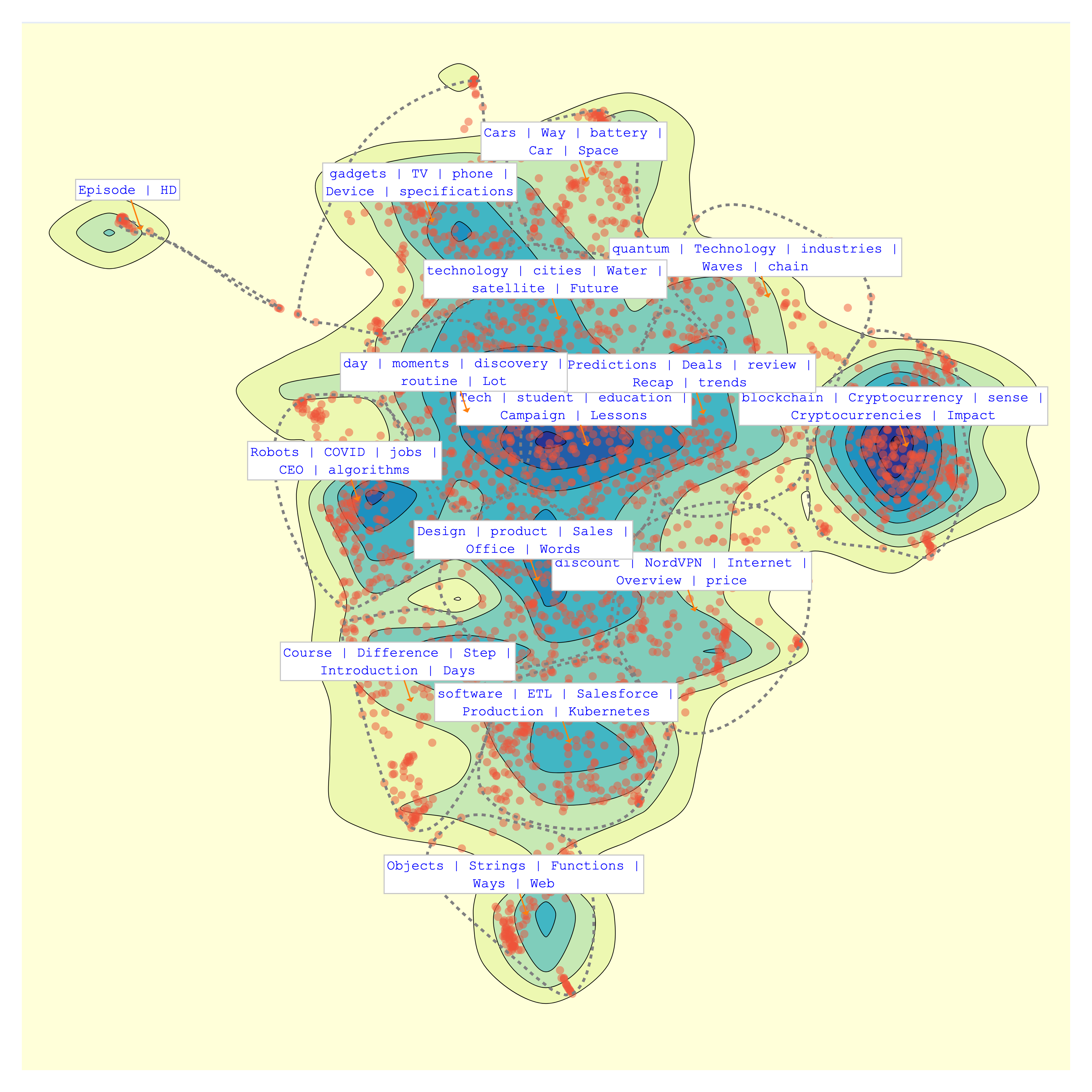
Topic Modeling with GenAI Summarization of Topics¶
Explore the power of Generative AI for summarizing topics! We use the 7B-instruct model of Mistral AI from the huggingface hub using the langchain framework.
from langchain.llms import HuggingFaceHub
# Define the repository ID for Mistral-7B-v0.1
repo_id = 'mistralai/Mistral-7B-v0.1'
# Using Mistral AI to Summarize the Topics
llm = HuggingFaceHub(repo_id='mistralai/Mistral-7B-v0.1', huggingfacehub_api_token="HF_TOKEN")
# Obtain clean topic names using Generative Model
bunka.get_clean_topic_name(generative_model=llm, language='english')
bunka.visualize_topics( width=800, height=800, colorscale = 'Portland')
Finally, let's visualize again the topics. We can chose from different colorscales.
>>> bunka.visualize_topics(width=800, height=800)
| YlGnBu | Portland |
|---|---|
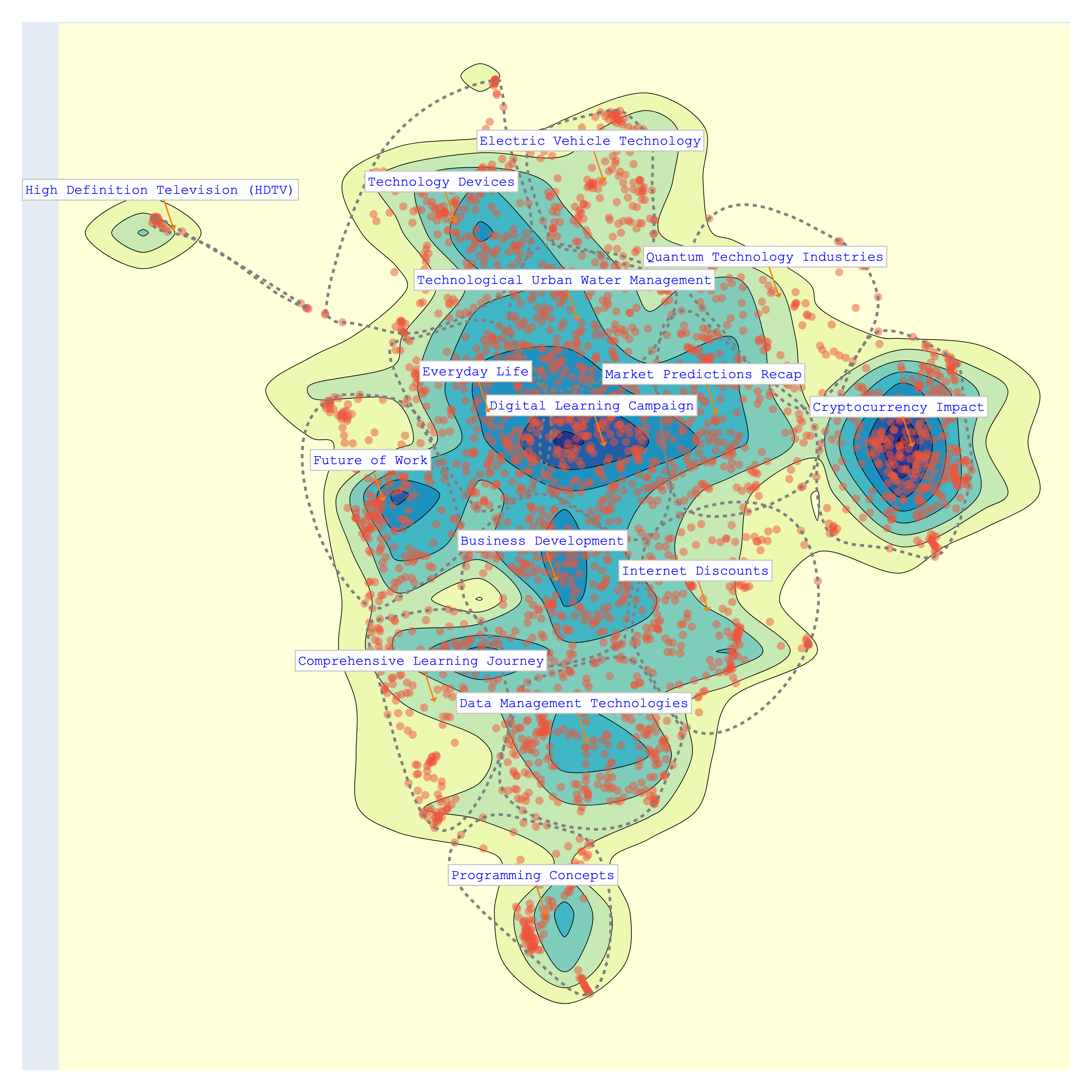 |
 |
| delta | Blues |
|---|---|
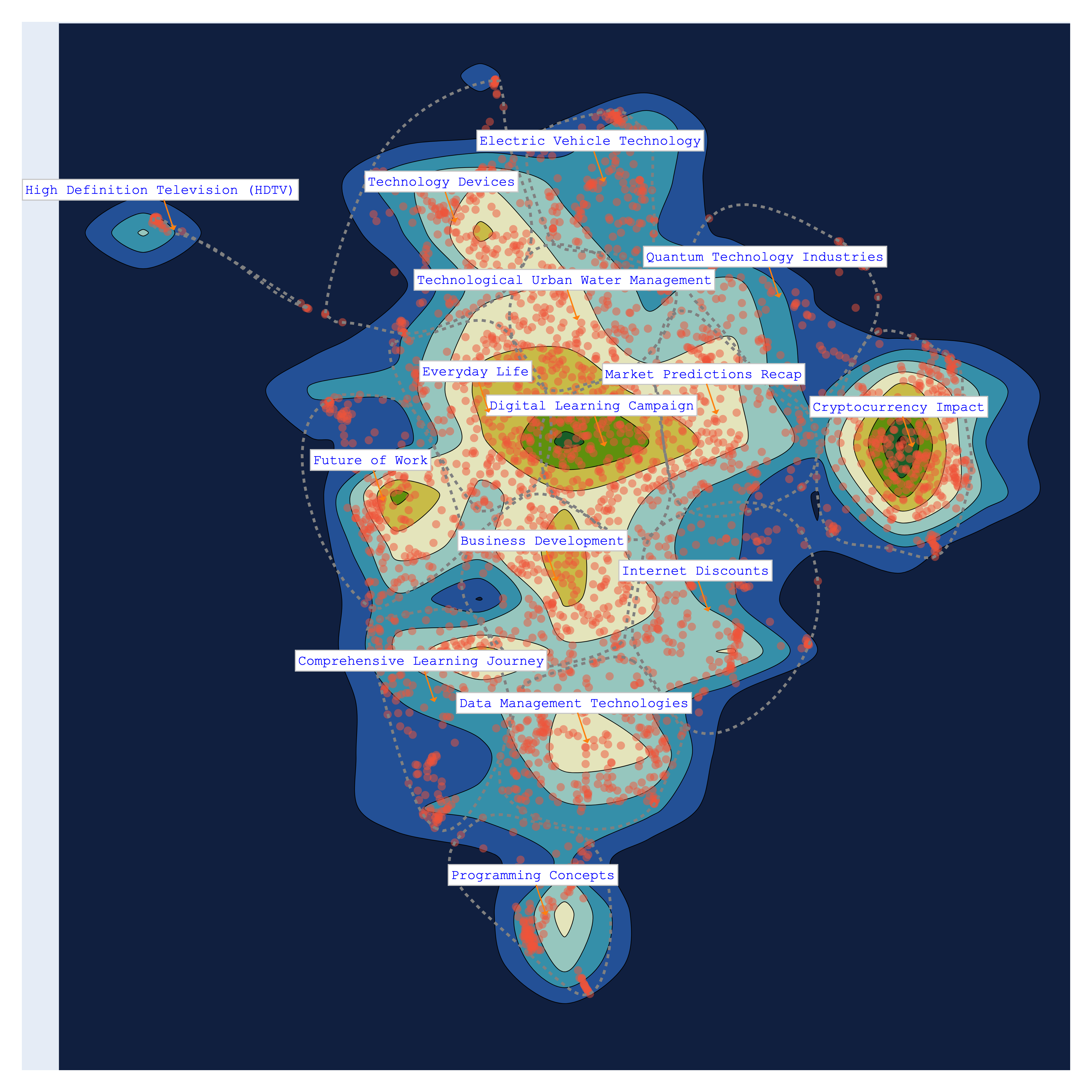 |
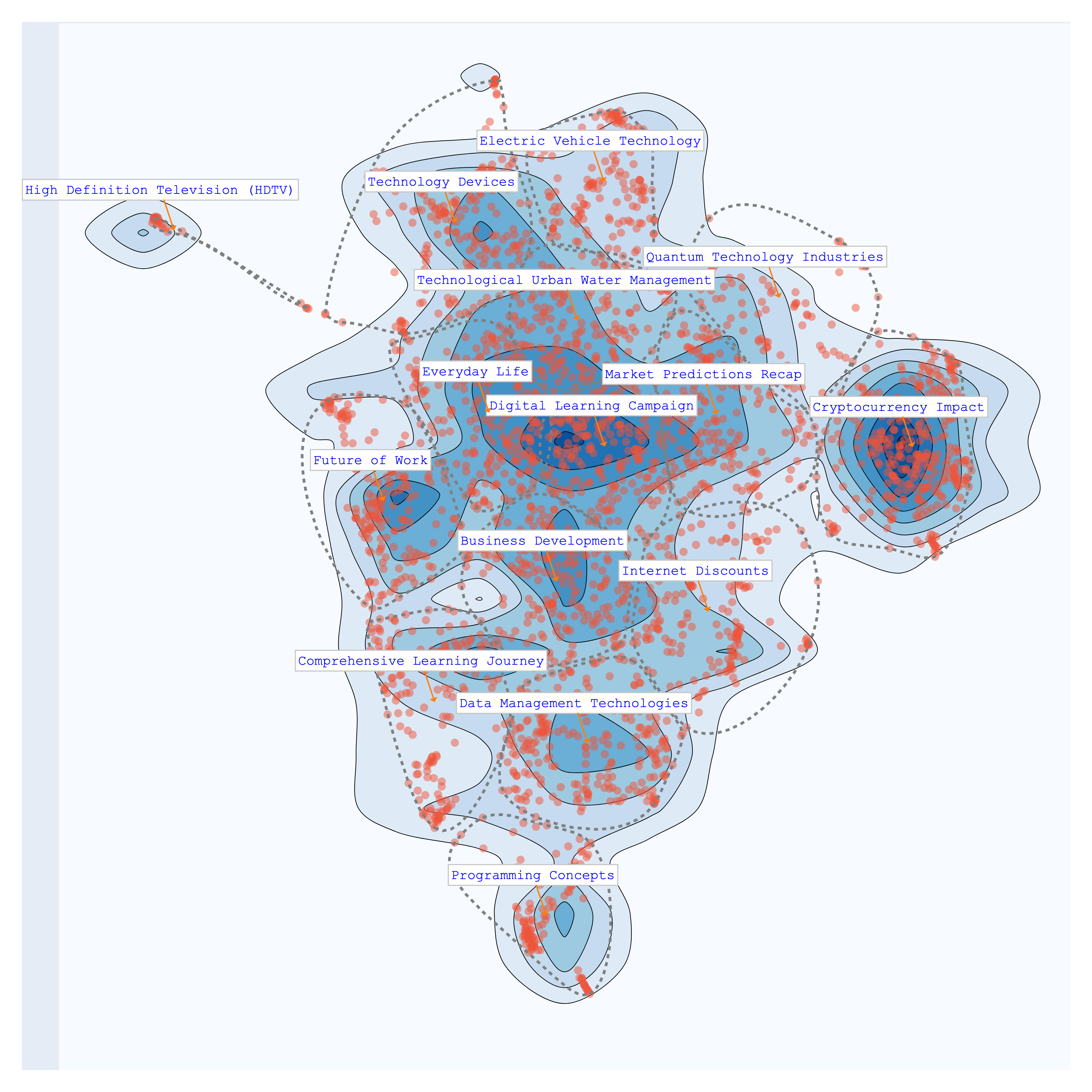 |
We can now access the newly made topics
>>> bunka.df_topics_
| topic_id | topic_name | size | percent |
|---|---|---|---|
| bt-1 | Cryptocurrency Impact | 345 | 12.32 |
| bt-3 | Data Management Technologies | 243 | 8.68 |
| bt-14 | Everyday Life | 230 | 8.21 |
| bt-0 | Digital Learning Campaign | 225 | 8.04 |
| bt-12 | Business Development | 223 | 7.96 |
| bt-2 | Technology Devices | 212 | 7.57 |
| bt-10 | Market Predictions Recap | 201 | 7.18 |
| bt-4 | Comprehensive Learning Journey | 187 | 6.68 |
| bt-6 | Future of Work | 185 | 6.61 |
| bt-11 | Internet Discounts | 175 | 6.25 |
| bt-5 | Technological Urban Water Management | 172 | 6.14 |
| bt-9 | Electric Vehicle Technology | 145 | 5.18 |
| bt-8 | Programming Concepts | 116 | 4.14 |
| bt-13 | Quantum Technology Industries | 105 | 3.75 |
| bt-7 | High Definition Television (HDTV) | 36 | 1.29 |
Manually Cleaning the topics¶
If you are not happy with the resulting topics, you can change them manually. Click on Apply changes when you are done. In the example, we changed the topic Cryptocurrency Impact to Cryptocurrency and Internet Discounts to Advertising.
>>> bunka.manually_clean_topics()
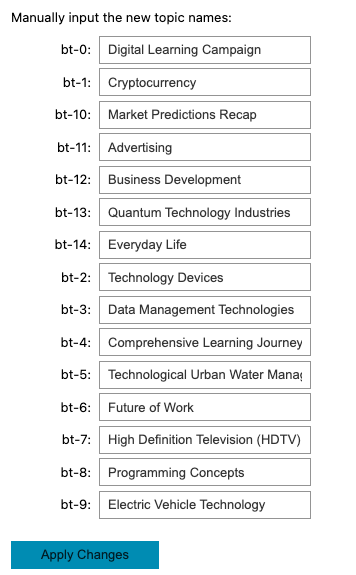
Removing Data based on topics for fine-tuning purposes¶
You have the flexibility to construct a customized dataset by excluding topics that do not align with your interests. For instance, in the provided example, we omitted topics associated with Advertising and High-Definition television, as these clusters primarily contain promotional content that we prefer not to include in our model's training data.
>>> bunka.clean_data_by_topics()
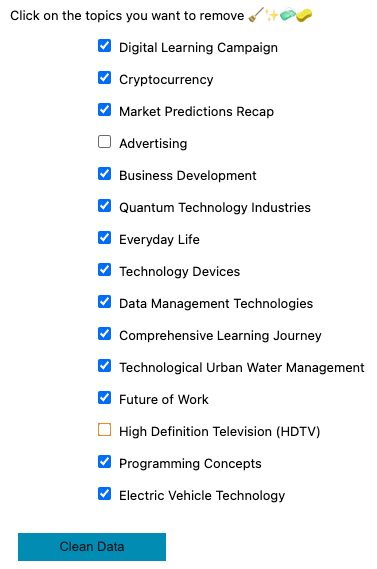
>>> bunka.df_cleaned_
| doc_id | content | topic_id | topic_name |
|---|---|---|---|
| 873ba315 | Invisibilize Data With JavaScript | bt-8 | Programming Concepts |
| 1243d58f | Why End-to-End Testing is Important for Your Team | bt-3 | Data Management Technologies |
| 45fb8166 | This Tiny Wearable Device Uses Your Body Heat... | bt-2 | Technology Devices |
| a122d1d2 | Digital Policy Salon: The Next Frontier | bt-0 | Digital Learning Campaign |
| 1bbcfc1c | Preparing Hardware for Outdoor Creative Technology Installations | bt-5 | Technological Urban Water Management |
| 79580c34 | Angular Or React ? | bt-8 | Programming Concepts |
| af0b08a2 | Ed-Tech Startups Are Cashing in on Parents’ Insecurities | bt-0 | Digital Learning Campaign |
| 2255c350 | Former Google CEO Wants to Create a Government-Funded University to Train A.I. Coders | bt-6 | Future of Work |
| d2bc4b33 | Applying Action & The Importance of Ideas | bt-12 | Business Development |
| 5219675e | Why You Should (not?) Use Signal | bt-2 | Technology Devices |
| ... | ... | ... | ... |
Bourdieu Map¶
The Bourdieu map provides a 2-Dimensional unsupervised scale to visualize various texts. Each region on the map represents a distinct topic, characterized by its most specific terms. Clusters are formed, and their names are succinctly summarized using Generative AI.
The significance of this visualization lies in its ability to define axes, thereby creating continuums that reveal data distribution patterns. This concept draws inspiration from the work of the renowned French sociologist Bourdieu, who employed 2-Dimensional maps to project items and gain insights.
from langchain.llms import HuggingFaceHub
# Define the HuggingFaceHub instance with the repository ID and API token
llm = HuggingFaceHub(
repo_id='mistralai/Mistral-7B-v0.1',
huggingfacehub_api_token="HF_TOKEN"
)
## Bourdieu Fig
bourdieu_fig = bunka.visualize_bourdieu(
llm=llm,
x_left_words=["This is about business"],
x_right_words=["This is about politics"],
y_top_words=["this is about startups"],
y_bottom_words=["This is about governments"],
height=800,
width=800,
clustering=True,
topic_n_clusters=10,
density=False,
convex_hull=True,
radius_size=0.2,
label_size_ratio_clusters=80)
>>> bourdieu_fig.show()
| positive/negative vs humans/machines | politics/business vs humans/machines |
|---|---|
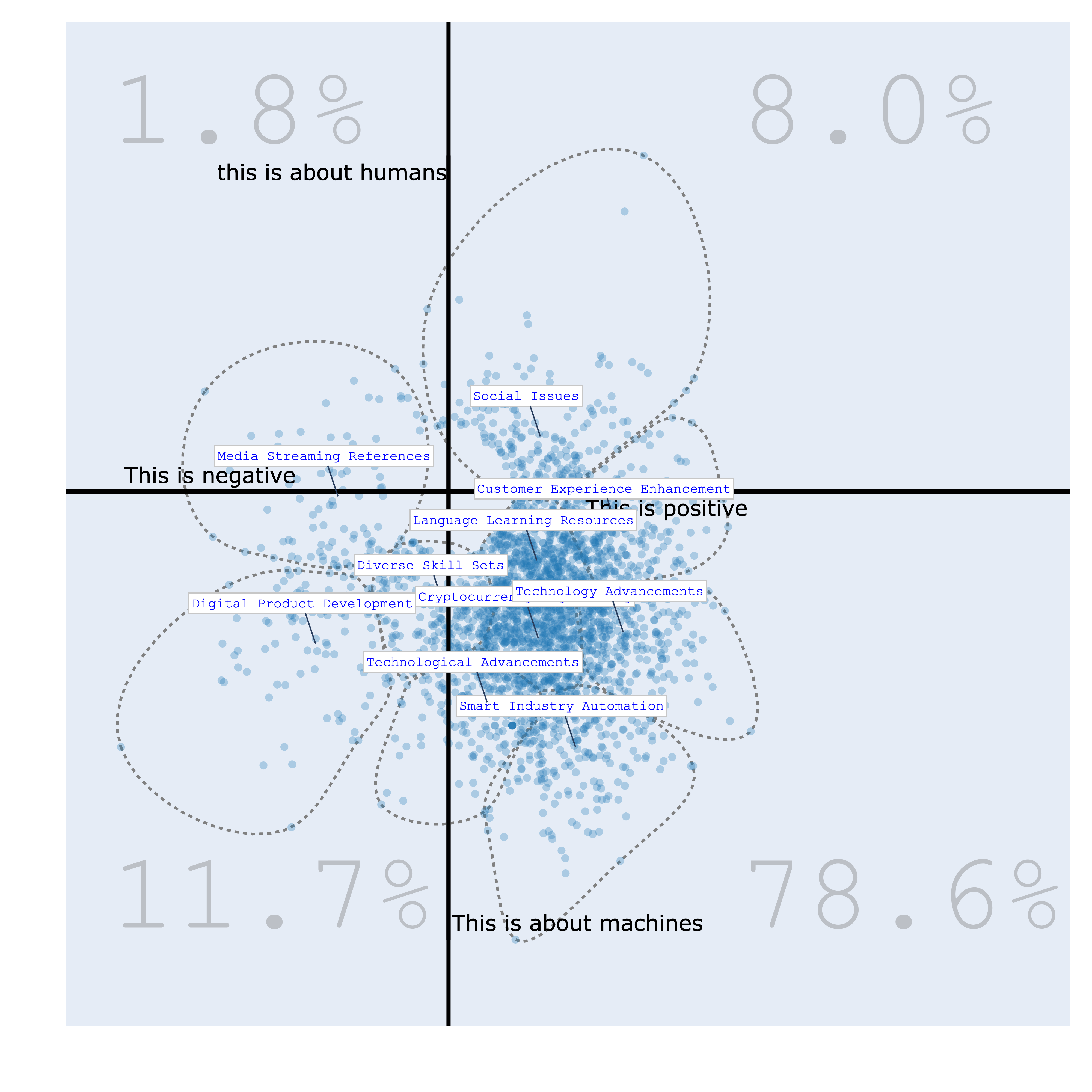 |
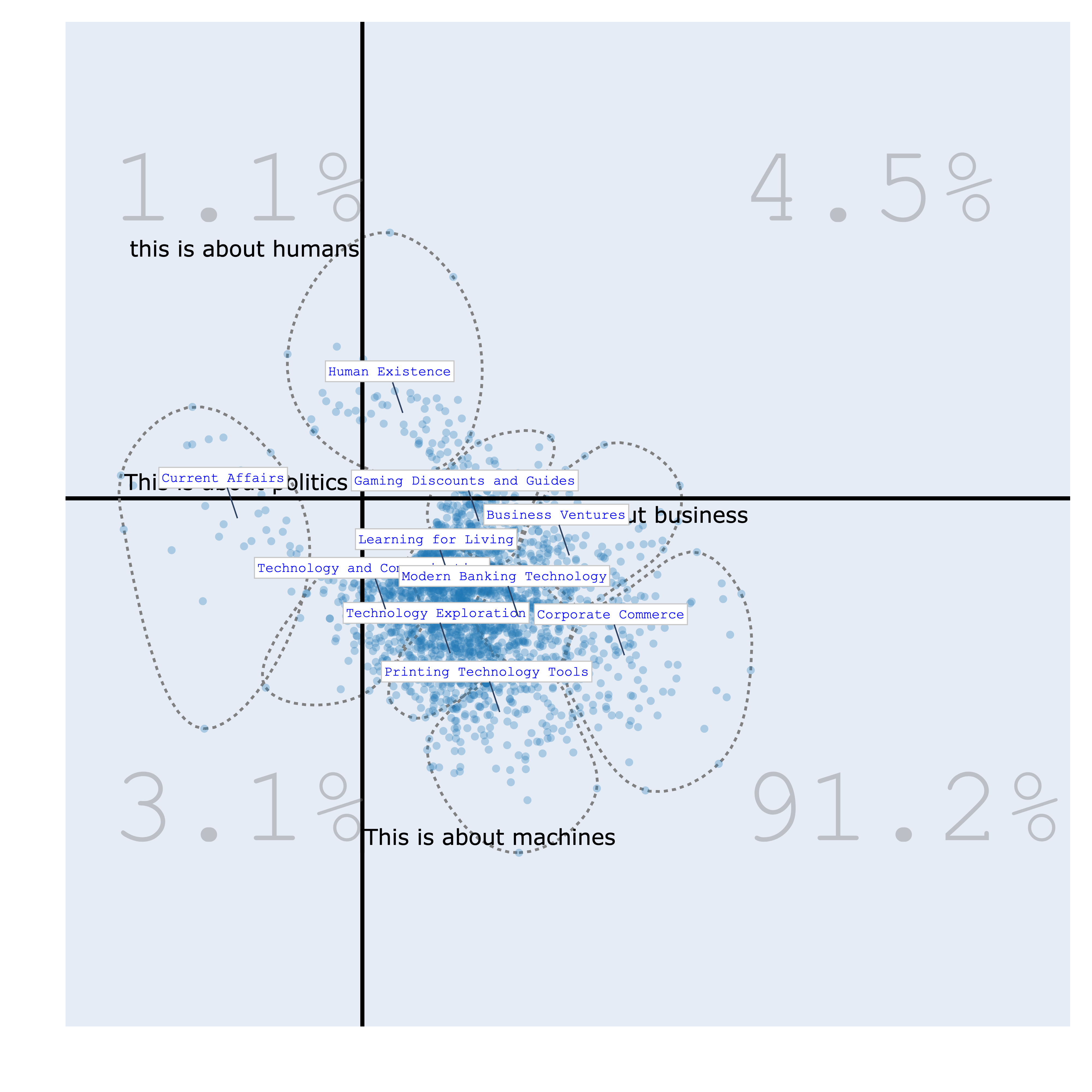 |
| politics/business vs positive/negative | politics/business vs startups/governments |
|---|---|
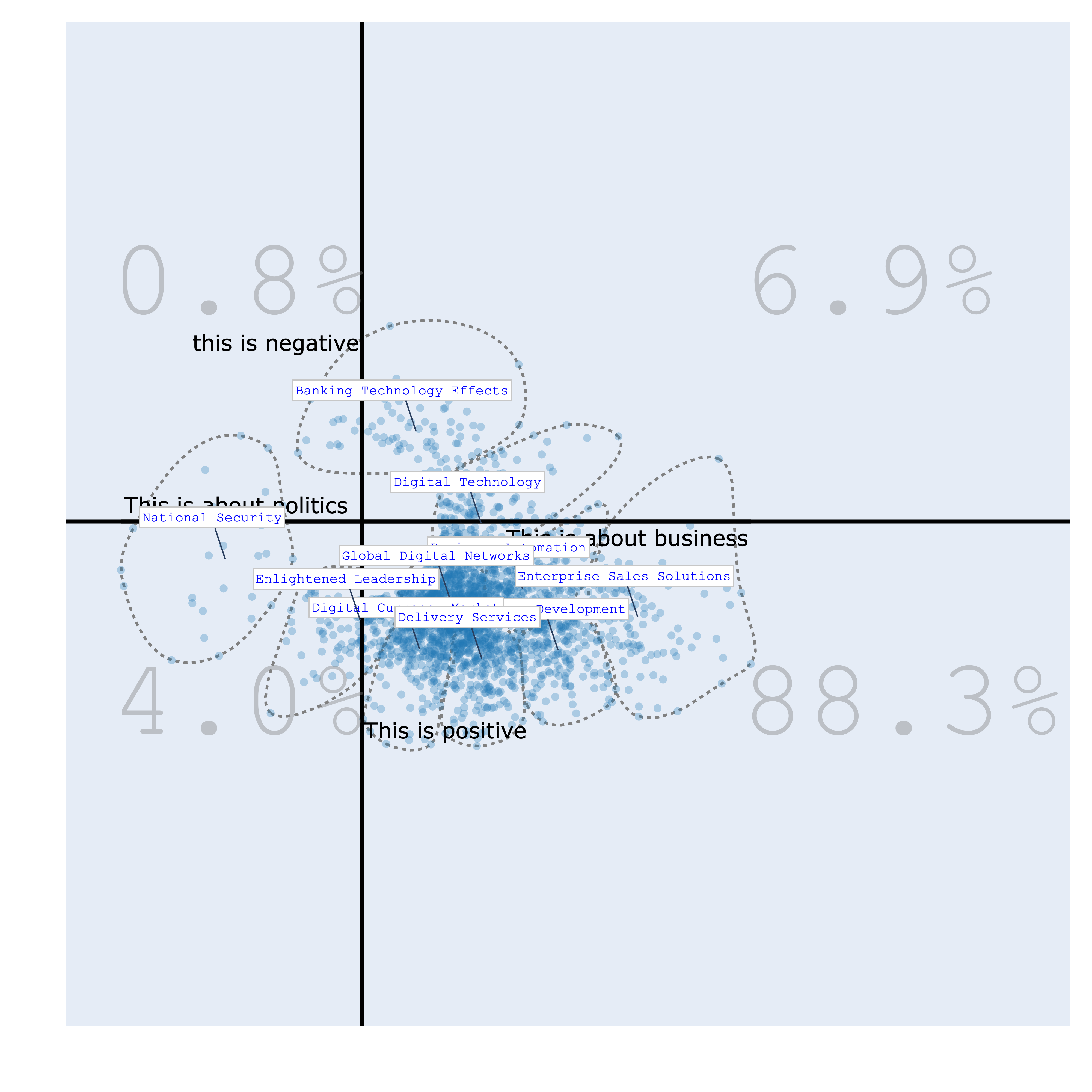 |
 |
Front-end¶
This is a beta feature. First, git clone the repository
git clone https://github.com/charlesdedampierre/BunkaTopics.git
cd BunkaTopics
pip install -e .
Then carry out a Topic Modeling and launch the serveur:
from bunkatopics import Bunka
from langchain_community.embeddings import HuggingFaceEmbeddings
# Choose your embedding model
embedding_model = HuggingFaceEmbeddings(model_name="all-MiniLM-L6-v2") # We recommend starting with a small model
# Initialize Bunka with your chosen model and language preference
bunka = Bunka(embedding_model=embedding_model, language='english') # You can choose any language you prefer
# Fit Bunka to your text data
bunka.fit(docs)
bunka.get_topics(n_clusters=15, name_length=3)# Specify the number of terms to describe each topic
>>> bunka.start_server() # A serveur will open on your computer at http://localhost:3000/



